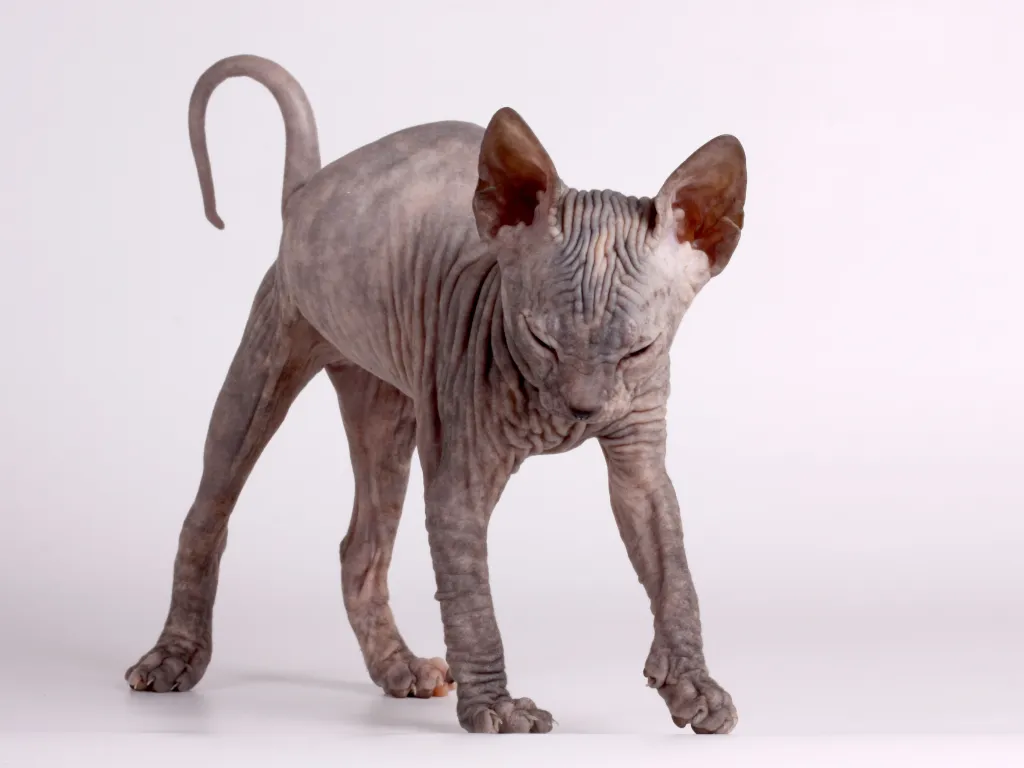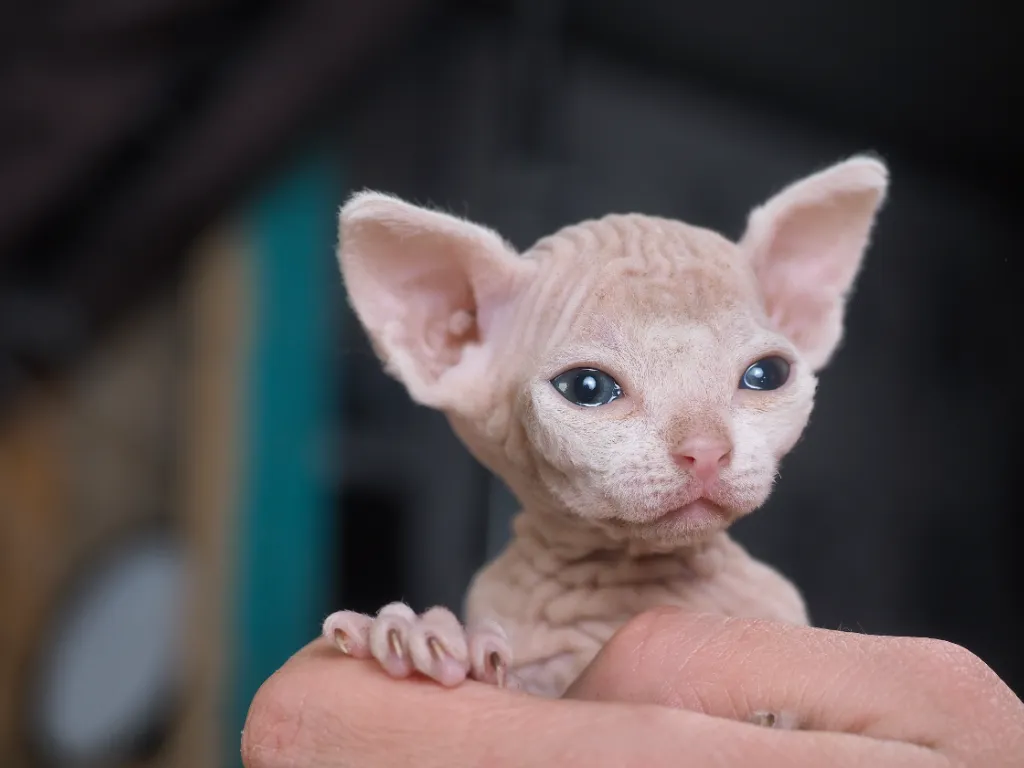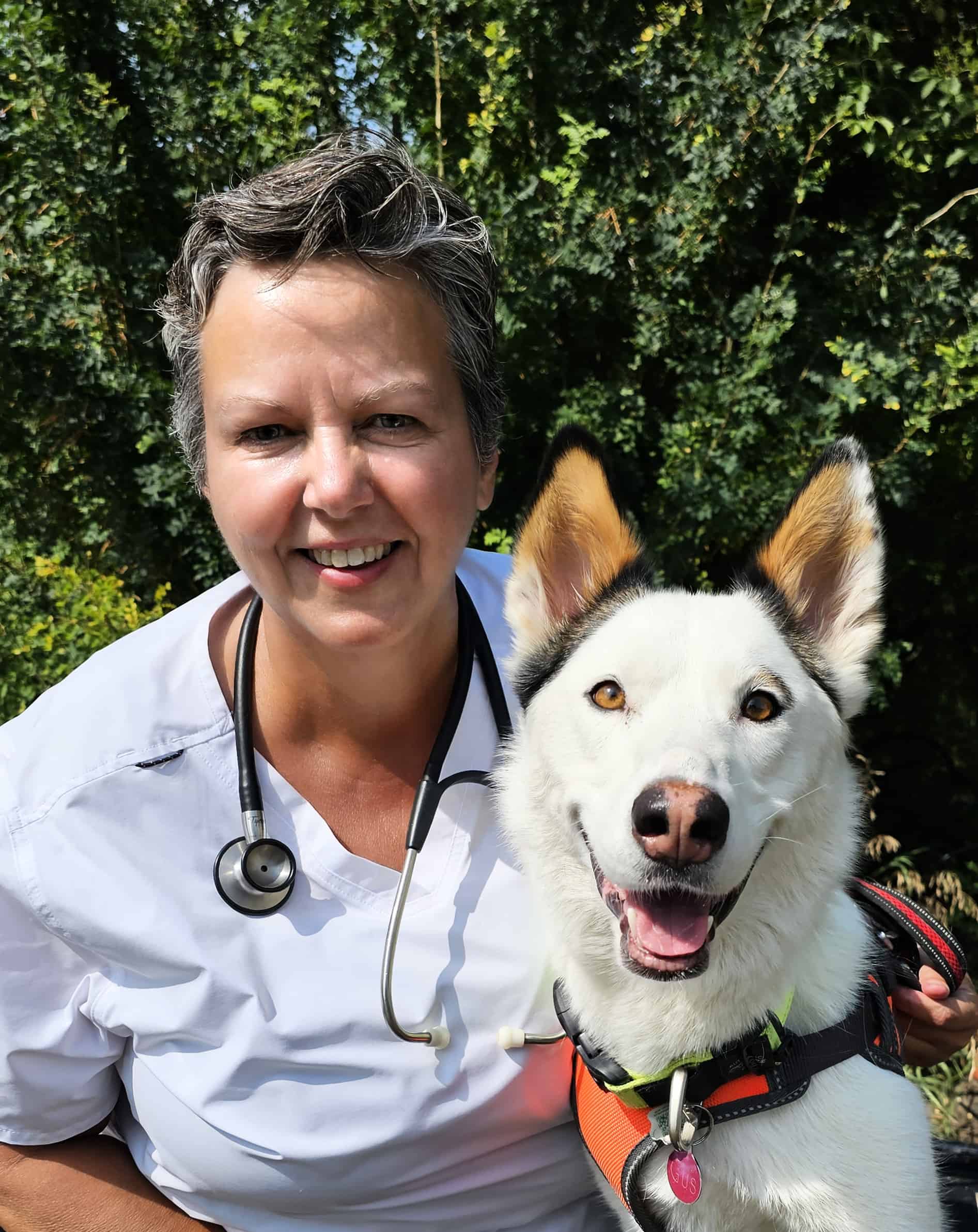Sphynx cats are truly exceptional among cat breeds, with their distinct lack of fur making them different from nearly all other feline companions. It’s impossible not to notice their hairlessness, and many people are curious about this trait. So why are Sphynx cats hairless?
Sphynx cats are hairless due to a natural genetic mutation affecting their coat. This mutation disrupts the normal development of hair follicles, resulting in a lack of a full fur coat. They are not, however, completely hairless – even the ‘baldest’ of Sphynx cats have some very fine, down hairy that may be difficult to see.
In this blog post, we’ll explore why Sphynx cats are hairless and uncover some interesting facts about this fascinating breed.
Sphynx Cat Appearance: 8 Typical Sphynx Cat Traits
Hairlessness aside, Sphynx cats have a distinct and unique appearance that sets them apart from other cat breeds. Once you know what to look for, there is no mistaking a Sphynx for any other breed of cat.
Here are 8 Sphynx cat traits that make them look distinct from other cats:
- Hairlessness: The most noticeable feature of Sphynx cats is, of course, their lack of a full fur coat. While they may have a very fine layer of downy fuzz on their skin, or even patches of fur, they appear mostly hairless, which gives them their distinctive look.
- Wrinkled Skin: Sphynx cats often have loose, wrinkled skin, particularly around their face and neck.. These wrinkles give them an expressive and charming appearance.
- Large Ears: They have relatively large, bat-like ears that are wide at the base and taper to a rounded point. Their ears are prominent and contribute to their alert and curious expressions.
- Lemon-Shaped Eyes: Sphynx cats have large, almond-shaped eyes that are typically a vivid color, such as green, blue, or gold. The eyes are set wide apart, giving them a captivating and intense gaze.
- Slender Body: Sphynx cats have a sleek, muscular, and slender body shape. Their lack of fur accentuates their underlying muscles, and their body proportions are well-balanced.
- Long, Thin Tail: They have a long, thin tail that tapers to a pointed tip, which is very flexible and expressive. The tail complements their overall sleek and graceful appearance.
- Variety of Colors: Sphynx cats come in various colors and patterns, just like other cat breeds. The lack of fur often makes their skin color more apparent, and their skin pigment may vary, ranging from pink to dark grey or other shades.
- Whiskers: Despite being hairless, Sphynx cats still have whiskers, which can be either sparse or more prominent, depending on the individual cat.

Why Are Sphynx Cats Hairless?
The hairlessness in Sphynx cats is a result of a naturally occurring mutation in the KRT71 gene. This mutation affects the production of hair. There is another known mutation of this same gene which results in the short, curly coat of the Devon Rex breed.
In this article, we have designated the genetic mutation that causes the Sphynx cat’s hairless coat as the “HR’ gene (hairless gene), and the normal, non-mutated gene as the “N” gene.
Here’s a more detailed explanation of the genetics behind Sphynx cats’ hairlessness:
- Autosomal Recessive Inheritance: The hairlessness trait in Sphynx cats is inherited as an autosomal recessive trait. This means that the gene responsible for hairlessness is located on one of the non-sex chromosomes (autosomes) and that two copies of the HR gene are required for the hairless trait to be expressed.
- The Hairless Gene (HR): The gene controlling the expression of hair is present in the DNA of all cats, but in most breeds (those with normal hair) it exists in the normal state (N). Sphynx cats have two copies of the mutated form, HR, which causes hairlessness.
- Normal Coat Gene (N): The N coat gene is responsible for producing a full fur coat in cats. In most cat breeds, this is the common gene, and cats carrying two copies of the normal coat gene (N/N) will have a normal, furry coat.
- HR Gene Mutation Origin: The HR gene mutation in Sphynx cats is thought to have arisen spontaneously. This mutation disrupts the normal process of hair follicle development and leads to the absence of a full fur coat in affected cats.
- Homozygous Expression: To be hairless, a Sphynx cat must inherit two copies of the HR gene – one from each parent. In genetics, an individual that carries two identical copies of a gene (in this case, two copies of the HR gene) is said to be “homozygous” for that gene.
- Heterozygous Expression: If a Sphynx cat inherits one copy of the HR gene and one copy of the N gene , it is said to be “heterozygous” for the hairless gene. These cats will have a more traditional fur coat and are carriers of the hairless trait, meaning they can pass it on to their kittens even if they have normal hair themselves.
- Breeding Hairless Cats: To produce hairless Sphynx cats, breeders must carefully select cats that are either hairless (homozygous for the HR gene) or carriers of the hairless gene (heterozygous). Breeding two hairless cats (HR/HR) will result in hairless kittens all of the time. Breeding a hairless cat (HR/HR) with a carrier (HR/N) will result in hairless kittens 50% of the time. Breeding a carrier (HR/N) to another carrier (HR/N) will result in hairless kittens 25% of the time.
Are All Sphynx Cats Hairless?
Sphynx cats are not completely hairless. While they are known for their hairlessness, even the most “bald” Sphynx cats have a fine fuzz covering their skin.
Their appearance can vary significantly in terms of hairlessness, and some cats may even have patches of fur on certain parts of their bodies.
The degree of hairlessness in Sphynx cats can vary from one individual to another. Not all Sphynx cats are as hairless as others. Some may have a nearly hairless appearance across their entire body, while others may have more pronounced patches of fuzz on certain areas like the ears, paws, tail, or face.
Additionally, Sphynx cats’ hairlessness can also change depending on the season and environmental factors. During colder months, they might grow a bit more fuzz to provide some insulation and warmth. In warmer weather, they might have less fuzz as their bodies adjust to the temperature.
These cats requires a controlled environment because they lack a protective fur coat. You can find out more about this topic in our article on The Best Temperature for Sphynx Cats.

Conclusion
Sphynx cats are a unique and fascinating breed that have captured the hearts of cat lovers around the world. While their hairlessness may seem odd, it’s simply a result of a naturally occurring genetic mutation that is maintained by careful breeding programs.
These cats require special care and attention to stay healthy and comfortable since they lack protective fur, but they are well worth the effort for those who appreciate their quirky personalities and striking appearance.
If you are considering adopting a Sphynx cat, be sure to do your research and find a reputable breeder or rescue organization that can provide you with the support and information you need to care for these unique pets.
You can learn more about Sphynx cats by checking out our complete breed and information guide here.


